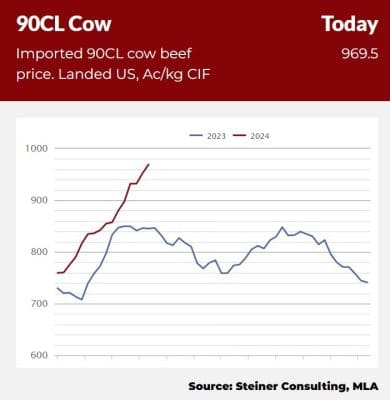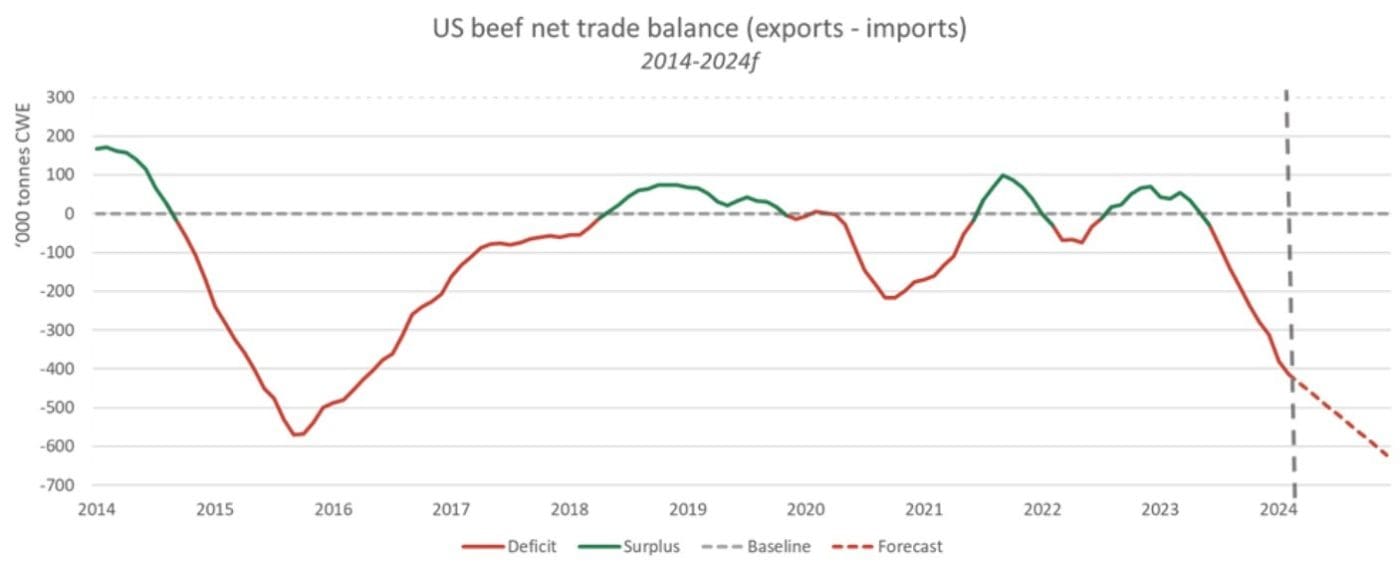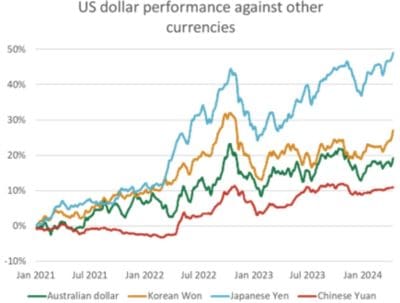THIS year’s dramatic surge in frozen beef trimmings prices – driven heavily by the US market – has taken a breather over the past week, but the consensus is that the pause is only temporary.
Lean 90CL frozen Australian imported trimmings, used as a foundation for the equivalent of around one billion US hamburgers each year*, last Thursday were trading at A969.5c/kg – their highest level seen in 24 years of recorded trade data.
 Market traders say business has softened a little this week, but there is no real sign that the trend seen over the past three months is reaching its end.
Market traders say business has softened a little this week, but there is no real sign that the trend seen over the past three months is reaching its end.
“The market had to take a breather at some point – it just had to,” a veteran trader into the US market told beef Central this morning.
This week’s prices are being buoyed somewhat by an Aussie dollar trading this week in the low to mid 64s (USc), but the underlying reason for the price surge is US demand.
Current prices are now officially the highest ever seen, eclipsing even a brief spike in the market seen in 2019 due to widespread COVID sickness among US meatworkers which squeezed the US domestic supply capacity for a short period, causing panic buying of Aussie trim.
With only six days to go to complete April export shipment data, it’s clear that volume of Australian frozen beef trimmings into the US this month is going to reach another big number.
DAFF’s progressive export shipment data for the period 1-18 April shows trade to the US for the month to date is already at more than 17,200 tonnes, suggesting 25,000-27,000t may be well within reach.
That comes on top of booming March beef shipments to the US totalling 26,484t, up 58pc from the same period last year.
Domestic production of beef in the US is continuing to decline, which is pushing the amount of beef in cold stores down and pulling imports up.

Beef Central’s home-page industry dashboard graph
Aussie lean trimmings have never before hit A$10/kg, but the milestone now looks likely.
“We’re in rarified air,” a regular export meat trade source said this morning.
“But its impossible to tell how much more the market has in it. In USc/lb terms, quotes this week are anywhere from US290c/lb to US310c/lb, but trade has been thin for the past couple of days.”
“The only time the US trimmings market has ever gone beyond US300c/lb in the past, it was only very, very brief – and due to distortions brought on by COVID.”
Asked whether Aussie trimmings values now ran the risk of pricing themselves out of the US consumers’ budgets, he said it was “absolutely on the cards – as some people settle for a pork or chicken burger instead. When anything gets too expensive, consumers look for alternatives.”
‘That’s what’s going to ultimately limit the upside here.”
While beef processors across the ditch in New Zealand are only now cranking up their annual seasonal dairy cow kill, New Zealand product was already ‘well-sold’ in the US, one trader said.
“I don’t see a lot more volume coming out of New Zealand, given what’s been sold over the last couple of weeks,” he said. That fundamentally left Australia and Brazil (burdened by a full tariff for the remainder of the year) as export trimmings suppliers.
First quarter 2024 Australian beef export to the US reached just over 68,000t – the highest in-quarter level seen since 2015, and 79pc higher than the same quarter last year. As it has since September last year, the US remains Australia’s largest beef export customer by volume, accounting for 24.7pc of total beef export trade so far in 2024.
We’ll provide our regular monthly summary of full April exports some time next week, soon after DAFF’s data is released.
Largest US beef deficit since 2008
Last Friday, the US Department of Agriculture published its April Livestock and Poultry: World Markets and Trade report, which included updated forecasts of US beef imports and exports.
The forecast showed a substantial shift in prospective US trade flows. Although US export forecasts have been revised up slightly, US imports this year have been revised up by 184,000t carcase weight equivalent,, to 1.89 million tonnes.
This means that the net trade balance for 2024 (exports minus imports) has been revised down 175,000t to minus 622,000t – the largest beef deficit since 2008.

Source: USDA ERS, USDA FAS, MLA
MLA analyst Tim Jackson said US production has remained stubbornly high over the past two years, despite falling substantially from peaks in late 2022.
Previous climate models that predicted El Niño conditions for several years, which would have created the environment necessary for a substantial decline in beef production, have not come to pass.
The American National Oceanic and Atmospheric Administration was currently estimating an 85pc chance that El Niño will collapse in the US in the April-June period, and a 60pc chance of La Niña developing by August.
“If this comes to pass, it will slow down any potential US herd rebuild, and lead to higher production levels than we would otherwise expect,” he said.
As such, the 2024 production forecast was revised up a further 157,000t to 12.06 million tonnes, a 2pc decline from 2023 levels.
“Although a considerable decline, this is smaller than previously expected, and means that the US herd rebuild will start from a lower base, and take longer than previously understood,” Mr Jackson said.”
At this point, it is likely that the US herd will reach its smallest size this year, and a sustained rebuild will only begin in 2025.
US domestic consumption
Despite the uptick in forecast production, US imports are still forecast to rise considerably this year. This is because of a 343,000t increase in the US domestic consumption forecast, which domestic production will not be able to meet.
US domestic beef demand remains robust, and with a growing population and solid economy, that’s expected to continue. In fact, the US is currently growing at around twice the rate of the next-best member of the G7, and inflation is below most other peer countries.

Source: XCED, MLA
This, combined with a sharper lift in interest rates than other countries, has strengthened the US$ against other currencies. Since the start of 2021, the US$ has appreciated by 11pc against the Chinese Yuan, 20pc against the Aussie dollar, 27pc against the Korean won and 50pc against the Japanese Yen.
This effectively pulls beef towards the US, both by reducing the value of US exports and making US imports cheaper, Mr Jackson said. The increase in domestic consumption is likely to come by directing exports away from other markets, and into the US.
“Given this, regardless of the US herd rebuild, export volumes to the US are likely to continue rising. As American production continues to fall, this effect will become more pronounced, but any delay in herd rebuilding ultimately only drags out the period of depressed production for longer,” he said.
Imported trimmings being dragged higher by domestic trim prices
US analyst Len Steiner in his latest weekly imported beef market report, makes the point that as the US domestic fresh lean beef market goes higher, so to do imported values – at least in the current supply situation.
“The sharp run-up in domestic fresh beef prices during February and March helped pull up imported values, even as supply from Australia and New Zealand kept pouring in,” he said.
“It didn’t matter that at the time there was a fair amount of Brazilian product sloshing around. What mattered was that domestic US lean beef prices ‘tomorrow’ were expected to be a lot higher than ‘today’.”
The rally allowed US end-users and traders to establish positions for late spring and summer.
Last week, however, was the first week since December that domestic US fresh lean beef prices were lower than the week before.
“More important, in our opinion, was the fact that US fed beef supply has not declined as much as previously feared, and domestic fed beef values have so far failed to launch.”
“Suddenly (last week), buyers of imported beef figured they were already long enough and stopped chasing the market,” Mr Steiner said.
Lean and extra lean imported grinding beef prices were US3c cents lower than the previous week, although in some cases even bigger declines were registered. The decline was largely at the FOB level, with overseas trading generally at steady money.
“For experienced market participants the recent developments may not be that surprising,” Mr Steiner said. “After all, it is a ritual of spring to get buyers all excited covering needs in March and early April and then see the rally run out of gas by late April.”
“Every year is different, and there is only so much you can attribute to seasonal demand. Last December prices declined by more than the seasonal trend would suggest and this March the opposite happened. Does it mean then that current prices are near at top? Maybe, unless something else happens fundamentally to push prices higher.”
“In the near term, however, the recovery in domestic beef supplies appears to have eased some of the buyer angst.”
* Last year Australia sold around 180,000t of frozen trimmings to the US. This year the figure will be far larger. At a ‘generous’ pattie equivalent weight of 200g, last year’s tonnage represents at least 900 million beef patties.
